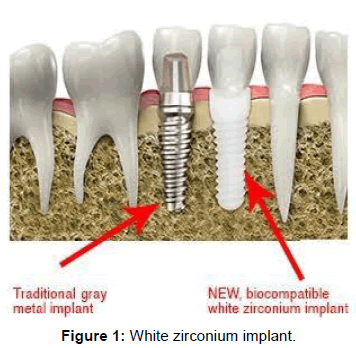Titanium to Ceramic Dental Implants: A Short Communication
Received: 06-Feb-2017 / Accepted Date: 28-Feb-2017 / Published Date: 10-Mar-2017 DOI: 10.4172/2572-4835.1000116
241145Zirconia ceramics is successfully used to fabricate tooth-supported restorations and this has stimulated clinicians to encompass its application for restorations with implants. CAD/CAM technology combined with zirconia ceramic is gaining more and more popularity in implant dentistry. The introduction of zirconia implants served as an alternative to titanium implants in dental implantology. Zirconia appears to be a proper implant material due to its opacity, low plaque affinity, mechanical properties and biocompatibility [1,2].
Gingival recession and apical bone loss connected with implants many a times expose portions of the metal implant, showing the overlying gingiva’s bluish discoloration. This complication is avoided by the use of zirconia implants and complies with the request of several patients for metal-free implants. Bone resorption and the inflammatory response caused by ceramic particles are less compared to those caused by titanium particles, signifying the biocompatibility of ceramics [2-4].
Nowadays most of the implant manufacturers provide zirconia abutments for restorations with aesthetic implants. Abutments are offered in customized or prefabricated forms and may be prepared in the dental laboratory by using CAD/CAM techniques or by the technician. Zirconia’s biocompatibility toward epithelial and soft connective tissue is vital. Furthermore-TZP abutments can support soft tissue integration, whereas promising peri-implant soft tissues can be achieved clinically adjacent to zirconia healing caps and zirconia implants [3,5] (Figure 1).
In addition to strength considerations, abutments of Y-TZP implant provide metal-like radio-opacity for improved radiographic assessment, and finally condensed bacterial adhesion, inflammation risk and plaque accumulation. A methodical evaluation revealed that zirconia abutments might maintain a corresponding bone level when compared to aluminum oxide, titanium and gold ones. In one randomized and controlled trial twenty customized, non-HIPed based Zirconia single tooth implant abutment and same number of titanium single tooth implant abutments were observed for three years, with no cases of loosening or fractures in both the groups and reported 100% survival rates [6].
References
- Christel P, Meunier A, Dorlot JM, Crolet JM, Witvoet J, et al. (1988) Biomechanical compatibility and design of ceramic implants for orthopedic surgery. Ann N Y Acad Sci 523: 234-256
- Noumbissi S (2013) Ceramic Dental Implants: An Alternative to Titanium and Titanium Alloys. Arch CranOroFac Sc 1: 37-39
- Gupta (2016) A Recent Updates on Zirconia Implants: A Literature Review. Dent Implants Dentures 1: 1-6
- Koutayas SO, Vagkopoulou T, Pelekanos S, Koidis P, Strub JR (2009) Zirconia in dentistry: part 2. Evidence-based clinical breakthrough. Eur J Esthet Dent 4: 348-380
- Siddiqi A, Payne AG, Duncan WJ (2011) Titanium allergy: could it affect dental implant integration? Clin Oral Implants Res 22: 673-680
- Zembic A, Sailer I, Jung RE, Hammerle CH (2009) Randomized-controlled clinical trial of customized zirconia and titanium implant abutments for single-tooth implants in canine and posterior regions: 3-year results. Clin Oral Implants Res 20: 802-808
Citation: Saurabh G (2017) Titanium to Ceramic Dental Implants: A Short Communication. Dent Implants Dentures 2: 116. DOI: 10.4172/2572-4835.1000116
Copyright: © 2017 Saurabh G. This is an open-access article distributed under the terms of the Creative Commons Attribution License, which permits unrestricted use, distribution, and reproduction in any medium, provided the original author and source are credited.
Select your language of interest to view the total content in your interested language
Share This Article
Recommended Journals
Open Access Journals
Article Tools
Article Usage
- Total views: 5883
- [From(publication date): 0-2017 - Aug 30, 2025]
- Breakdown by view type
- HTML page views: 4807
- PDF downloads: 1076

